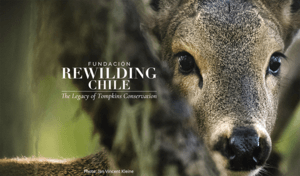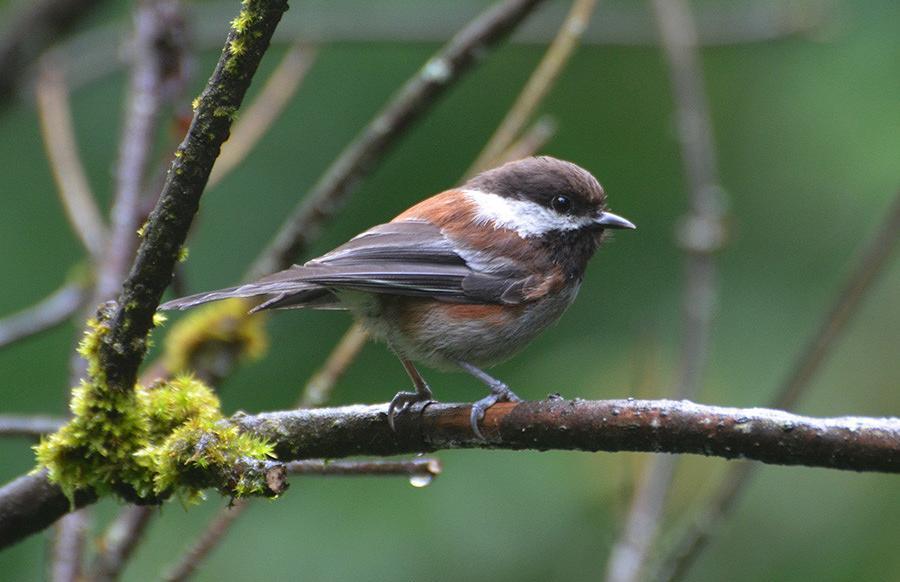
FOSTERING WILDLIFE-FRIENDLY FARMING And Recognizing Biodiversity As Critical to a Fully Functioning Farm
By Jo Ann Baumgartner, Wild Farm Alliance

Jo Ann Baumgartner c/o WFA
We support what is beautiful and what we love—songbirds singing out their names, fat bumblebees busy sampling an array of gorgeous native flowers, and the majestic oaks towering over us—these animals and plants can and do live on farms. Are they what make a farm beautiful?
There’s a debate raging here and especially in Europe where eco-payments are made to farmers to protect rare species. It goes like this: Should we have agricultural sacrificial zones separate from protected wild places, or should we have wildlife-friendly farms. The sacrificial zones are where the crop is grown fencerow to fencerow and every other plant is killed with herbicides or fire, and livestock are confined to small areas and are not allowed to graze. The Wild Farm Alliance (www.wildfarmalliance.org) maintains that from every perspective—beauty, functionality, and biodiversity—we must have both large protected areas and wildlife-friendly matrices.
Agriculture comprises almost 60% of the contiguous United States, and 40% of the Earth’s landscape. As our population grows and our planet heats up, it is imperative that we recognize the benefits biodiversity provides—particularly, pollination, pest control, clean water, and fertile soils. These biodiversity benefits can help the farm be more resilient to changes in climate that will cause increasing drought, heat waves, and floods. Among the most important components of biodiversity, natural predators help control pests and diseases, and help prevent over-browsing of plant communities. A biologically diverse farm, then, is addressing the global extinction crisis.
In my mind, a beautiful farm is one where the farmer makes a living not just on the land, but from the diversity of the natural world. In so doing, that farmer has a richer experience interacting with nature (as opposed to solely growing corn and soybeans, over and over), and ultimately, supports wild nature.
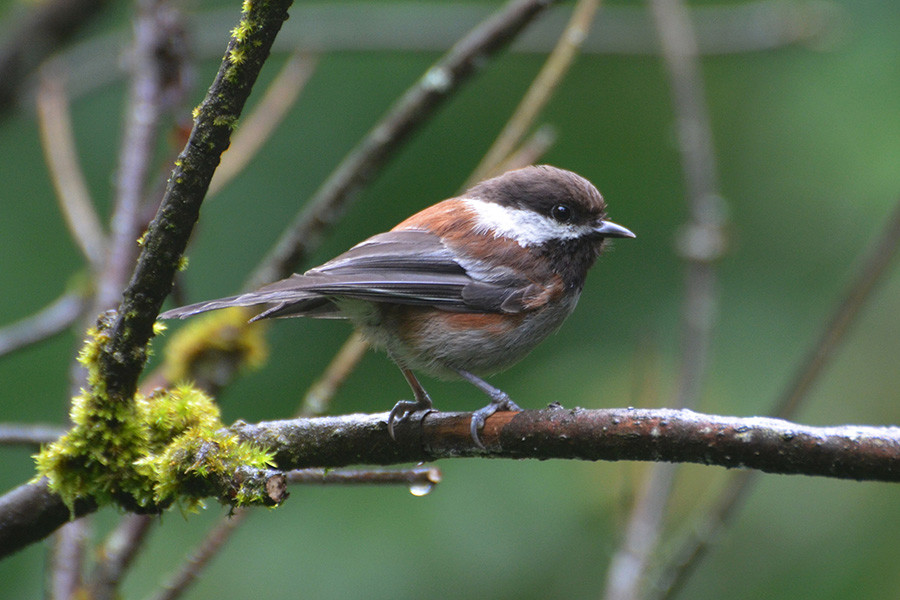
Chestnut backed chickadee c/o A.Reago & C. McClarren
Take a walk with me through a few diversified farms in the Central Coast of California. Let’s start at Live Earth Farm. The songbirds are now singing every morning because it is breeding season—the insectivorous ones like the Chestnut-backed Chickadees are eating codling moth so the proverbial worm that would have been in the apple instead helps to feed their young. The oak trees that are interspersed throughout the farm (especially on steeper slopes that aren’t tilled), support up to 5000 insect species—500 of which are caterpillars in their larval stage—big food sources for nestlings. While worldwide honeybees (a species introduced from Eurasia) are in decline, native bees are helping to take up the slack, especially on this farm where conserved native habitat provides nectar and pollen and nesting sites –hollow stems for tunnel-nesting bees and open ground for ground-nesting bees. Corridors for wildlife movement are protected on the farm. Come summer, the apricots are to die for, the tomatoes exquisite, and the multitude of other produce, amazing. As these crops bloom, they are giving back to the pollinators and beneficial insects, supporting some of their food needs.
Of course, there are trade-offs to coexistence with nature. For instance, the errant chicken that escaped its electrically fenced yard has become food for a Bobcat. Regional studies suggest that the birds farmers tend to see as pests (the non-insect-eating kind) consume about as many strawberries as the insectivorous birds save by eating the strawberry’s pest insects. Even with the trade-offs, the farm is viable and highly successful.
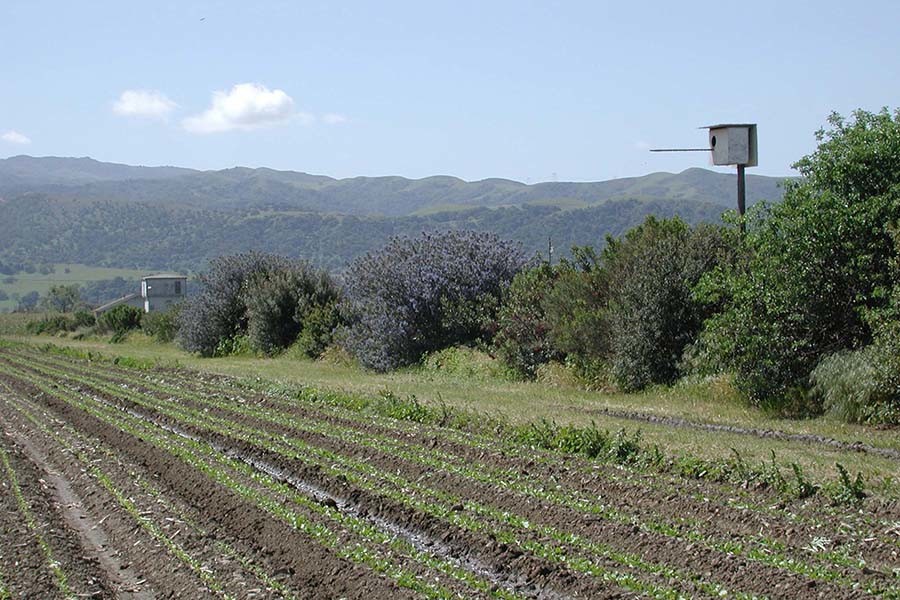
Foster Ranch Hedge & Barn Owl Box c/o WFA
Strolling through Phil Foster’s Ranch, we see the crop diversity as varied as Live Earth Farm’s, but it is more in the flatlands where there are fewer wild corridors and edges. Nevertheless, a restored riparian area stabilizes the river banks and helps support wide-ranging predators that keep rodents in check; and huge native plant hedgerows support beneficial native bees and natural enemy insects and birds. The riparian corridor and the hedgerows also store woody carbon. Tradeoffs are managed with specific techniques. For example, the farmers plant the first few rows adjacent to one hedgerow with crops that aren’t attractive to pest birds; and use temporary fencing along another hedgerow when the crop is young to discourage foraging of the crop by the quail that have taken up residence in the hedgerow. In the end, the produce is as delicious as you can find—roast their flavorful bell peppers, caramelize their big red onions, steam their flat Italian green beans, eat their fresh cherries …
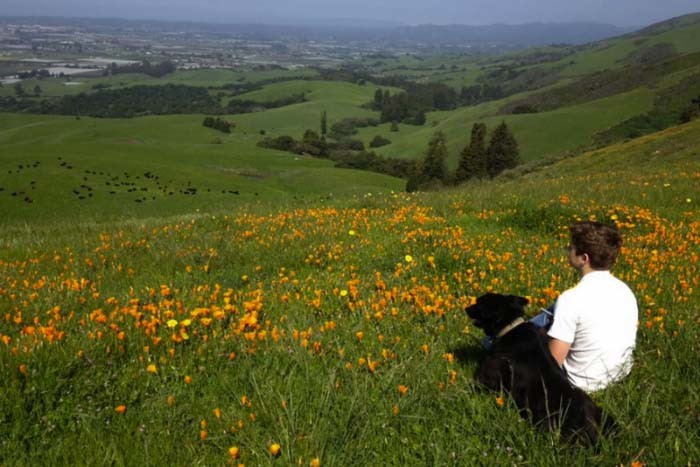
Morris Grassfed Beef c/o WFA
Our trail takes us to Morris Grassfed Beef’s operation where pasture-raised cattle graze on thousands of acres. Their holistically managed animals are rotated through the landscape to allow high quality forage, carbon sequestration in the soil, and maintenance of biodiversity. Wide-ranging wildlife such as mountain lions, coyotes, black-tailed deer, and hawks also use these landscapes. The cattle are treated with care which comes through in the meat—it is succulent, bite after bite, and good for you with higher amounts of beta-carotene, vitamin E and omega-3 fatty acids than beef produced using conventional cattle-feeding strategies. By never allowing the animals to overgraze, the ranchers maintain more vegetation in creeks and riparian areas. They are seeing more native than non-native grasses; and shrubs are retained, to support birds like the California Scrub Jay. The Jay is a restoration specialist, burying more acorns than it can find later, thereby fostering oak regeneration. If there is a trade off to such holistic livestock management, it is that rotational grazing is more labor intensive than just turning out the cattle –and letting them graze, and graze, until they overgraze the landscape.
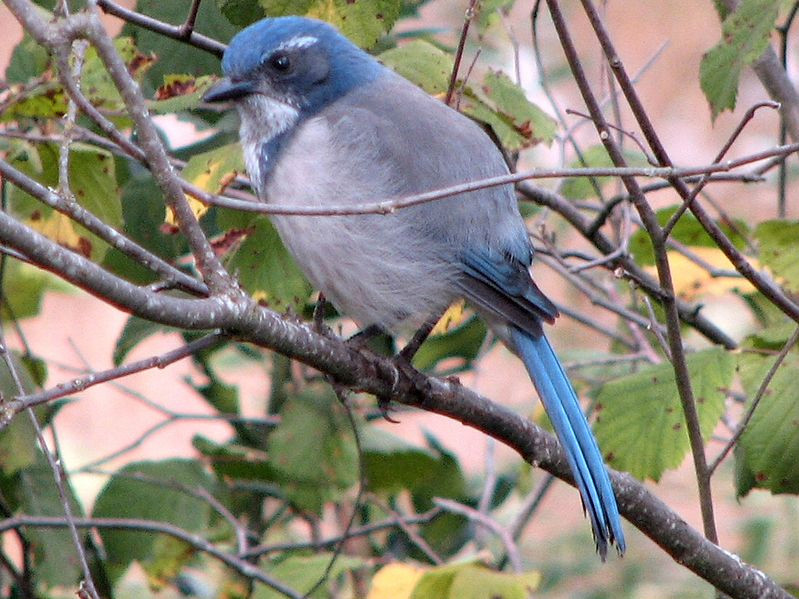
California Scrub c/o Jay Kersti Nebelsi
The last stop takes us through Deep Roots Ranch, a heritage breed operation raising cows, chickens, turkeys, and sheep. Even on smaller acreage, Deep Roots Ranch shows, farms can be integrated with nature. The secret to their success is that they are grass farmers—keeping the pasture healthy means matching the number of animals to what the grass can support. They’ve restored a muddy ditch back into a clear running creek through the middle of their property, supporting numerous songbirds and aquatic species. How many ways can you cook lamb? A fun and delicious way to find out is by purchasing an animal from Deep Roots.
Drive through other agricultural areas and you will see very different farming practices. Row crops are grown with “clean” edges and orchards with cleared understories where they could have supported pollinators and natural enemy insects—instead, these farms pay extra for pollination (beehives) and pest control (pesticides or beneficial insect releases). Animals are set apart from their natural food sources in small pens. If they are on pastures or rangeland, they are spread out on overgrazed land instead of moving through in tight groups (an evolutionary tactic for safety from predators). These conventional farms have a long way to go toward better ecosystem functionality provided by biodiversity.
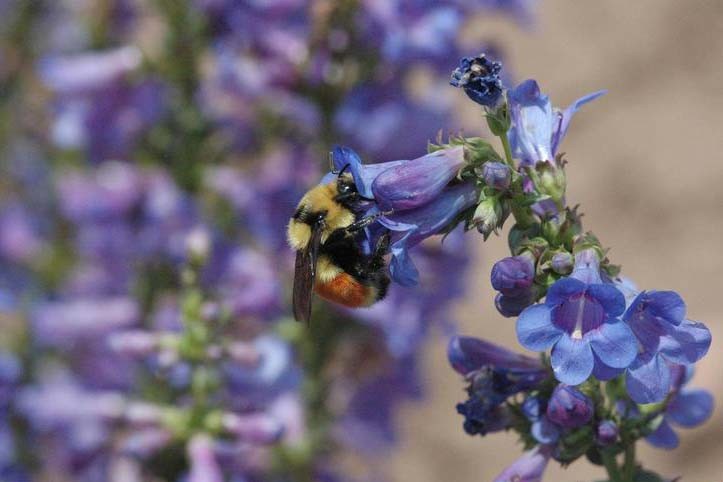
Bumblebee c/o Bob Hammon, Colorado State Univ. bugwood
Farmers can diversify their operations through various wildlife-friendly practices. Research from UC Berkeley is reinforcing that diversified farming systems progress and support the farm along a simple to complex continuum—from mixed cropping and livestock systems, cover crops, and hedgerows to riparian corridors on the farm and natural landscapes surrounding the farm. Wild Farm Alliance has identified several steps focusing on plant diversity that support biological diversity along the continuum:
- Rotate crops, and plant cover crops and pastures to support diverse microorganisms in the rhizosphere.
- Keep the soil covered with a crop, pasture plants, or non invasive plants as much as possible. Plant a cover crop understory in perennial crops. Allow non-invasive plants to grow along fencerows and in ditches.
- Manage plant pests without using pesticides that harm pollinators, beneficial insects, reptiles, amphibians, birds, bats or other mammals.
- Provide nectar and pollen by planting annual non-invasive sequentially flowering plants interspersed through the crop, at the ends of crop rows and in pastures.
- Plant native flowering buffer strips, hedgerows, and perennial understories for native plant-eating insects (frogs, lizards, birds, and mammals all rely on these as food sources).
- Increase food, cover and nesting sites by planting and conserving structural and compositional diversity of native trees, shrubs, forbs, and grasses on crop perimeters and interspersed through pastures.
- Create native plant corridors to connect with natural habitat patches and pastures in the farm and to larger natural areas off the farm. Support watershed level restoration.
- Conserve and restore grasslands, shrublands, woodlands, wetlands, and riparian areas, especially habitats of the highest conservation value that support rare species.
As more farmers use these kinds of diversified farming practices, we will have a mosaic of food production areas that get better and better at providing valuable ecosystem benefits.
Food makes us who we are, from our earliest remembrances of how a raspberry tasted, to what was served at an important celebration in our lives. Gastronomists believe we enjoy our food more when we identify with its origin – for example, people rate their enjoyment of eating shellfish higher when they are listening to sounds of the ocean.
Times are changing for food and farming. So many more people are paying attention to cooking shows and questioning where their food comes from. Much of that attention is focused on buying local and pesticide-free food. Local is about eating fresh food and supporting your human neighbors, and pesticide reduction means we and the many species that share this planet are less impacted by toxins. These actions are important, but not enough.
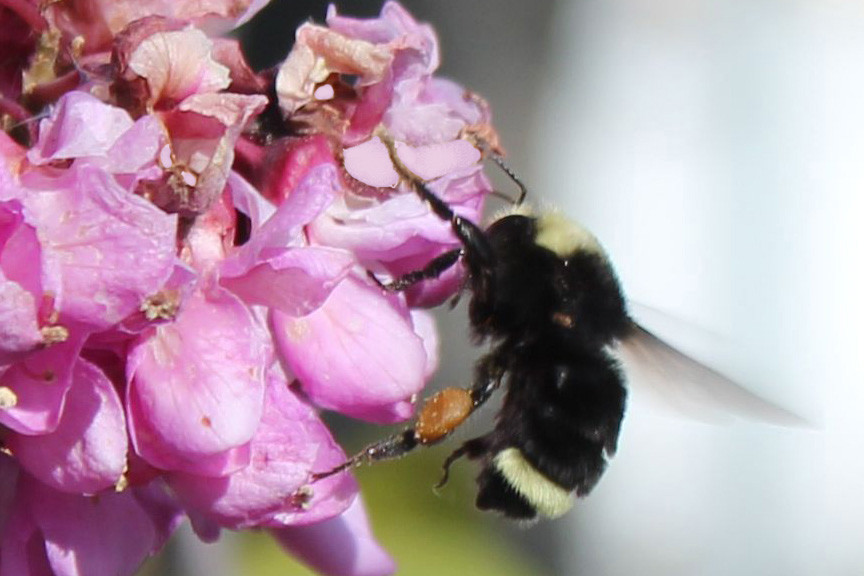
BumbleBee c/o J.Baumgartner
Food and farming embody more than that—they are about supporting the beauty and functionality that biodiversity provides on the farm. Diverse farming systems support our wild neighbors and the ecosystem. If you like eating that local pesticide-free apple, you just might love eating one that grew with native bees buzzing in its flowers, songbirds serenading and keeping it safe from pests, and creeks murmuring by. If farmers could share the sounds of nature from their farms, it would undoubtedly widen the enjoyment and support for their food. Consumers, farmers and ecologists are helping to evolve the food and farming movement to a new level—one that goes beyond organic to incorporate biodiversity in our world. Support beautiful farms along the biodiversity continuum!
_____________________________________
Download here: How to Conserve Biodiversity on the Farm: Actions to Take on a Continuum from Simple to Complex http://www.wildfarmalliance.org/biodiversity_continuum
Jo Ann Baumgartner is executive director of Wild Farm Alliance. She wrote the initial draft of the recently published USDA National Organic Program Natural Resources and Biodiversity Conservation Guidance; and is the main author of Co-Managing Farm Stewardship with Food Safety GAPs and Conservation Practices. Jo Ann co-edited, with Dan Imhoff, Essays in Farming and the Fate of Wild Nature: Conservation-Based Agriculture. Before joining WFA in 2001, she worked for other sustainable agricultural nonprofits, was senior researcher for a book of California’s rare wildlife species, and was an organic farmer for over a decade. She has a keen interest in the conservation of native species for their own sake, and the connections between farms and the larger ecosystem. Wild Farm Alliance promotes a healthy, viable agriculture that helps to protect and restore wild nature. www.wildfarmalliance.org
Jo Ann Baumgartner is executive director of Wild Farm Alliance. She is the co-author of Supporting Beneficial Birds and Managing Pest Birds and of Biodiversity Conservation: An Organic Farmer’s and Certifier’s Guide. Jo Ann co-edited, with Dan Imhoff, Farming and the Fate of Wild Nature: Essays in Conservation-Based Agriculture. Before joining WFA in 2001, she worked for other sustainable agricultural nonprofits, was senior researcher for a book of California’s rare wildlife species, and was an organic farmer for over a decade. She has a keen interest in the conservation of native species for their own sake, and the connections between farms and the larger ecosystem.

